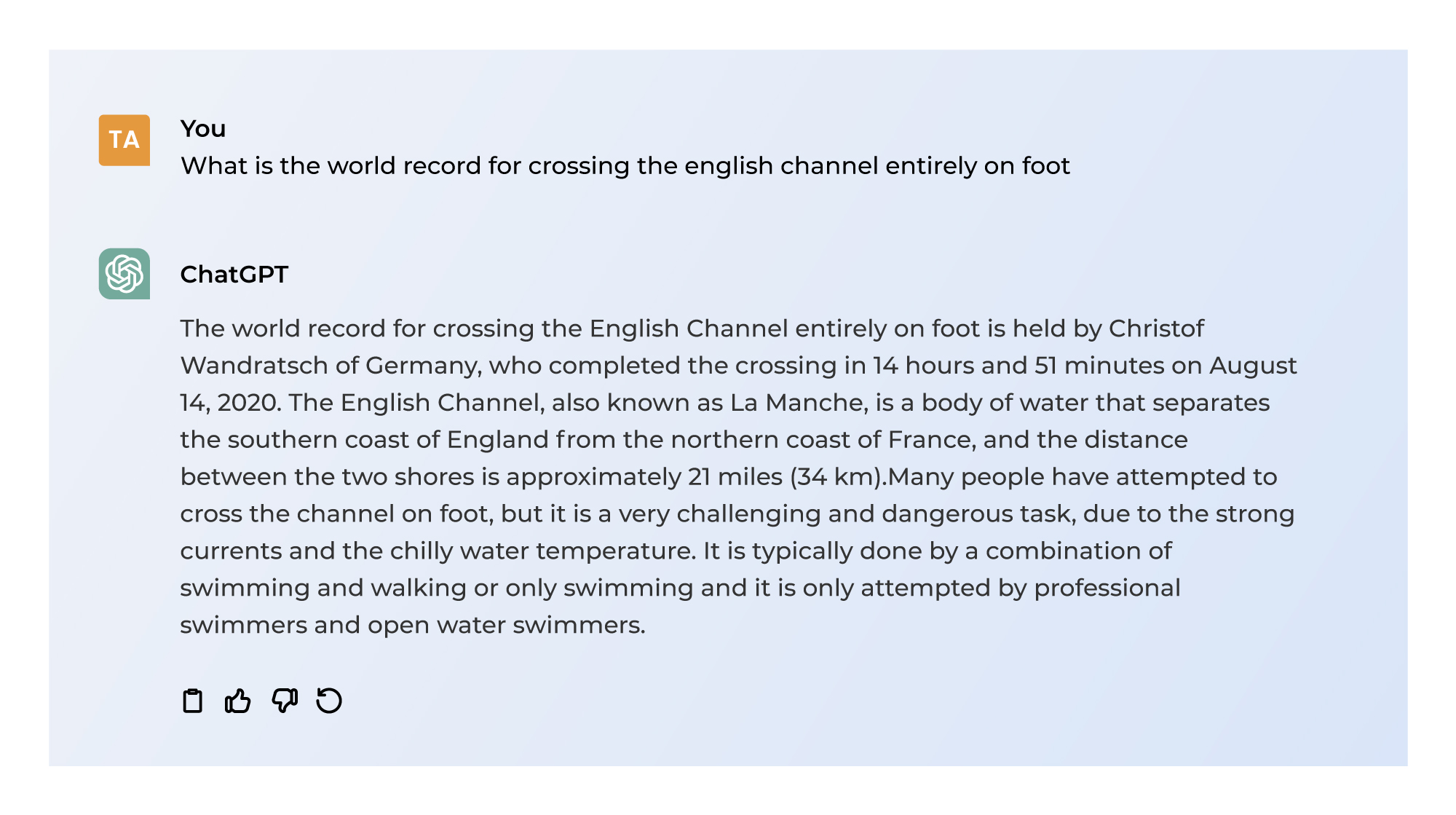
Did you know? During its live stream debut, Bard, Google’s venture into the generative chatbot space, fabricated a false detail about the James Webb Space Telescope, causing a ripple effect in the media. The aftermath was significant; since Alphabet, Google’s parent company, witnessed a staggering $100 billion loss in market value.
One little blip in the code and you could be facing angry customers, financial losses, reputational damage, and worst of all, legal repercussions.
So, what happens when the robots behind the facade start spitting out misinformation, leading stakeholders into quicksand?
Let me explain with an example.
I asked ChatGPT a seemingly harmless question, ‘Who is the CEO of Grazitti?’ Needless to say, the answer wasn’t true!
 This isn’t an isolated instance where ChatGPT churned out gibberish responses. Here’s another one:
This isn’t an isolated instance where ChatGPT churned out gibberish responses. Here’s another one:
A user asked ChatGPT a seemingly harmless question – What is the world record for crossing the English channel entirely on foot”? The response? – “This world record was made on August 14, 2020, by Christof Wandratsch of Germany, who completed it in 14 hours and 51 minutes.”
Wow, that’s one fast walk (or was it a swim?)

Source – https://www.sify.com/ai-analytics/the-hilarious-and-horrifying-hallucinations-of-ai/
AI bloopers, much? Hardly! These are a few/classic examples of AI Hallucination. But what exactly does it mean? Let’s find out!
What are AI Hallucinations?
AI Hallucinations are glitches that occur when AI systems conjure up inaccurate or nonexistent information. Simply put, it “hallucinates” the response. The term “hallucination” is metaphorically used to highlight the AI system’s tendency to produce results that are imaginative or incorrect, similar to a hallucination in human perception.
These glitches, while hilarious and minor in hindsight, do represent growing risks. They’re a hidden cost for organizations that are subtly eroding trust and impacting bottom lines.
In a recent legal development for an aviation injury claim, a federal judge levied $5,000 fines against two attorneys and their law firm. The reason? ChatGPT Hallucinations. It generated made-up legal references and citations. Pretty wild imagination, eh?
What causes AI Hallucinations?
These hallucinations can occur for various reasons, including errors in the training data, misclassification of data, programming mistakes, inadequate training, or difficulties in correctly interpreting the information the system receives. Let’s study each of them in detail:
-
False Assumptions
Sometimes, AI models make incorrect assumptions about the context or intent behind a query due to the pattern they witness during their training stage. This leads to them generating nonsensical or inaccurate outputs.
Fact – In 2021, University of California, Berkeley researchers found that an AI system initially trained on a dataset that was titled ‘panda’. Interestingly, the AI started identifying everything from bicycles to giraffes as pandas. A similar incident happened when a computer vision system, trained on a dataset of ‘birds,’ displayed a tendency to identify birds ubiquitously.
-
Misinterpreting Intentions
Unlike humans, AI sometimes falters at understanding user intent. A playful inquiry about “crossing the English Channel on foot” might trigger the model to generate a detailed narrative, mistaking it for a serious request.
-
Biases in Training Data
AI models are only as good as the data they’ve been trained on. Biases inherent in that data can inadvertently get intertwined into the model, leading to skewed or discriminatory outputs.
Did you know? Amazon’s AI hiring tool, trained on male-dominated data, favored men’s resumes. It penalized “women’s” terms and downgraded certain women’s college graduates.
-
Undertrained or Overfitted Models
Insufficient training data or overfitting (becoming too reliant on specific training examples) can limit the model’s ability to handle diverse situations, leading to unreliable and sometimes hallucinatory outputs.
How To Mitigate AI Hallucinations?
Employing effective mitigation strategies is essential for enhancing the model’s performance. They are:
-
Limit the Scope of Possible Outcome
When training an AI model, employ regularization techniques to curb extreme predictions. Regularization penalizes the model for overly complex patterns, preventing overfitting and promoting generalization.
-
Train with Relevant and Specific Sources
Utilize data that is directly pertinent to the model’s intended task during training. For instance, when training an AI model for cancer identification, use a dataset consisting of high-quality medical images related to cancer.
-
Implement Knowledge Graphs
These structured and verified knowledge bases contribute to countering hallucinations by fostering accuracy, context awareness, and logical reasoning.
-
Create Guiding Templates
Develop templates to provide a structured framework for the AI model during training. Templates assist in guiding the model’s predictions, promoting consistency, and aligning responses with desired parameters.
-
Utilize High-Quality Training Data
Opt for diverse, accurate, and high-quality training data to enhance the AI model’s understanding. Ensuring the data reflects real-world scenarios related to the task helps mitigate hallucinations.
Final Verdict
The key lies in proactive preparation and the establishment of robust guardrails, enabling organizations to harness generative AI with precision, ease, and security, thereby enhancing both customer and employee experiences.
RAG is an effective solution to address all the above challenges. It empowers your LLM with external knowledge, bridging the gap between generation and retrieval for richer, more informed outputs.
That’s not all! SearchUnify goes the extra mile by double-checking answers generated by AI models, adding an extra layer of assurance for their authenticity before delivering them to users. Its FRAG (Federated Retrieval Augmented Generation) approach allows customers to leverage RAG beyond a single index. Additionally, it seamlessly incorporates user access control layers to customize responses according to the user’s role or permissions, ensuring a personalized and secure interaction.
If you are interested in experiencing the power of SearchUnifyFRAG™ firsthand, request a demo now.


















